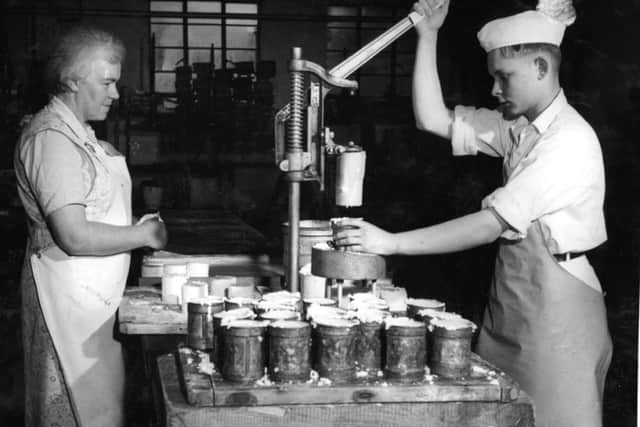You can’t rush a good cheese


Entire books have been devoted to the art of cheesemaking, each with hefty glossaries explaining the legion of technical terms.
Norman McCallum knows all the lingo and is well versed in pitching, pressing and ripening. However, none of the existing jargon quite summed up that moment when you know a cheese is at its peak of perfection. Which is why Norman invented his own.
Advertisement
Hide AdAdvertisement
Hide Ad“It’s what I call having a good judder,” says the Wensleydale Creamery’s veteran cheese grader, as he demonstrates the technique which he’s perfected over the last 30 years. “As soon as I put the corer into the cheese I know whether it’s right or not. It’s not something you can be taught, it’s something which comes with experience.”


Norman had no intention of devoting his life to the white stuff. In fact it was only when work slackened off at his joinery business that he took a temporary job at the creamery.
“I was only supposed to be here for two weeks. That was 30 years ago,” says Norman, whose only hint of his previous trade is a longing to bring back the old wooden shelves on which the cheese used to sit. These days, largely down to health and safety requirements, they’ve been replaced by metal versions. “They might be easier to clean, but they’re not so good at absorbing any extra moisture. If I could, I’d bring them back in a heartbeat. I began as a cheesemaker and learnt the whole process from the start to the finish, but I’m happiest here. This is the room for me. I couldn’t imagine working anywhere else.”
Norman has learned many skills over the years, but one he shares with all the creamery staff is patience – you can’t rush a good cheese. Curds have to separated from whey, the cheese has to be pressed and wrapped and when it finally arrives with Norman it can still be a further three months before it finds its ‘judder’ and is ready for sale.
Advertisement
Hide AdAdvertisement
Hide Ad“I always say it’s an art and a science,” says Norman. “You could give someone the exact formula of how to make Wensleydale, but unless you’ve got a feel for what makes a perfect cheese, unless you can taste, then it won’t work.”


The Hawes factory is run on almost military precision and a major investment is about to mark yet another chapter in a business which can trace its heritage back to the 12th century when Wensleydale monks first began experimenting with cheesemaking. As part of the £5m project, production of the creamery’s blended cheeses, mixed with the likes of apricot and cranberry, will move to its Ripon site and butter-making will return to Hawes for the first time since the 1980s. It is hoped the production side will be up and running by April and it will be followed by the opening of a new visitor centre in Wensleydale telling the story of the creamery.
In 2015 things are looking good for the business – exports to the Far East, America and New Zealand are growing and having been granted what’s known as PGI status the Yorkshire Wensleydale brand is more protected than its ever been.
However, it could have been a very different story as the creamery was almost consigned to history back in 1992.
Advertisement
Hide AdAdvertisement
Hide Ad“At the time it was owned by Dairy Crest and Hawes was just one of a number of creameries it operated around the country,”says David Hartley, who had been with the company just two years when it was announced the Wensleydale site had been earmarked for closure. “There hadn’t been much investment in the place for a number of years and it was mainly manufacturing Red Leicester.


“To some people perhaps it didn’t look like there was a lot to lose, but a few of us realised that there was 1,000 years of history here that was in danger of disappearing. I was 29 years old and took a calculated gamble. I thought it was worth trying to save the creamery and if it didn’t work within the first few years, well, I was still young enough to do something else.”
David’s gamble paid off and he never did have to find an alternative career. He’s now managing director of the company he helped save, a company which had grown out of a cottage industry and which had already defied closure once before.
While cheesemaking in the area may have begun with the monks, it thrived thanks to farmers’ wives and in 1897 when the first creamery was built in Hawes, it moved onto large-scale production. However, the depression of the 1930s hit the business hard and it was only thanks to the ingenuity and determination of local businessman Kit Calvert that it lived to fight another day.
Advertisement
Hide AdAdvertisement
Hide AdIt was Calvert who started a co-operative to rescue the company and it was he who standardised the manufacturing process to ensure every slab of cheese which left the creamery was the same as the last.
“I grew up in Lancashire, very close to the Yorkshire border and I knew about Kit Calvert before I ever moved to Hawes,” says David. “Funnily enough when I got my first job in the dairy industry, my father happened to be in the second hand bookshop Kit ran and by way of a good luck present he bought a couple of his books about the history of Wensleydale cheese and got him to sign them. Sadly, I never got to meet him, but I like to think we have been able to continue the tradition he started.”
While some of the manufacturing process has been automated – big vats are responsible for pitching and turning the curds and whey – most of it remains unchanged from Calvert’s day and while few looking to start a multi-million pound production and export business would choose to site it in Hawes, for the creamery its location remains key.
“We have a relationship with 45 different farms many of whom have supplied the creamery for generations,” says David.
Advertisement
Hide AdAdvertisement
Hide Ad“Some are quite small producers in the context of the dairy industry and had the creamery closed back in 1992 I suspect that today there wouldn’t be a dairy farm this side of Aysgarth.
“Hawes isn’t near a motorway, the road and rail links aren’t brilliant, but Wensleydale cheese tastes the way it does because of the milk we use and the whole operation is intertwined with the Dales countryside. Of course we are not a charity, we are a business and we have to make money, but if the groundswell of support we had both from the public and the media when the creamery was in danger of closing taught us anything, it was that people value a company which has heritage and which encapsulates something about the area in which it’s based.”
Touchy-feely credentials aside, in a crowded market the creamery has had to become savvy at marketing, which was demonstrated last summer as the Tour de France rolled into town. Few Yorkshire businesses could have afforded to be the race’s official partners, but with stage one of the route skirting through Hawes on the way up to Buttertubs Pass, one of the most spectacular stretches of the two day event, early on they knew there was a marketing opportunity to be be had.
It was David and the company’s marketing manager Sandra Bell who came up with the idea of turning hay bales into giant Wensleydale cheeses, which, along with the profusion of yellow bikes, became one of the most iconic images along the route.
Advertisement
Hide AdAdvertisement
Hide Ad“The coverage we got through social media was tremendous. We knew they would be popular, but we never guessed just how much people would love them.”
The company was similarly taken by surprise when it unexpectedly found itself being championed by animator Nick Parks in his Wallace and Gromit films back in the early 1990s. The firm successfully secured a licensing agreement with Aardman Animations to produce a Wallace and Gromit Wensleydale and when the first feature length film, Curse of the Were-Rabbit, was released in 2005, sales of Wensleydale cheeses reportedly jumped by almost a quarter.
“It really does show you the power of association,” says David, who confesses to a liking for a Wensleydale and tomato sandwich with cracked black pepper. “Brand awareness is key for any company and if you ask people what cheese does Wallace and Gromit eat, 99 per cent will immediately say Wensleydale. I suspect they will be with us forever.”
The company are continually tweaking their recipes and adding new lines, but back in the grading room Norman has more traditional tastes.
Advertisement
Hide AdAdvertisement
Hide Ad“I quite like an oat cracker and a small spoonful of chutney, but if I’m honest I’d happily just eat Wensleydale all by itself. In fact if I know I am going out with the boys for a few drinks I’ll make sure there’s a cheese platter ready to soak up the alcohol.”
If it’s good enough for Norman, that’s good enough for us.